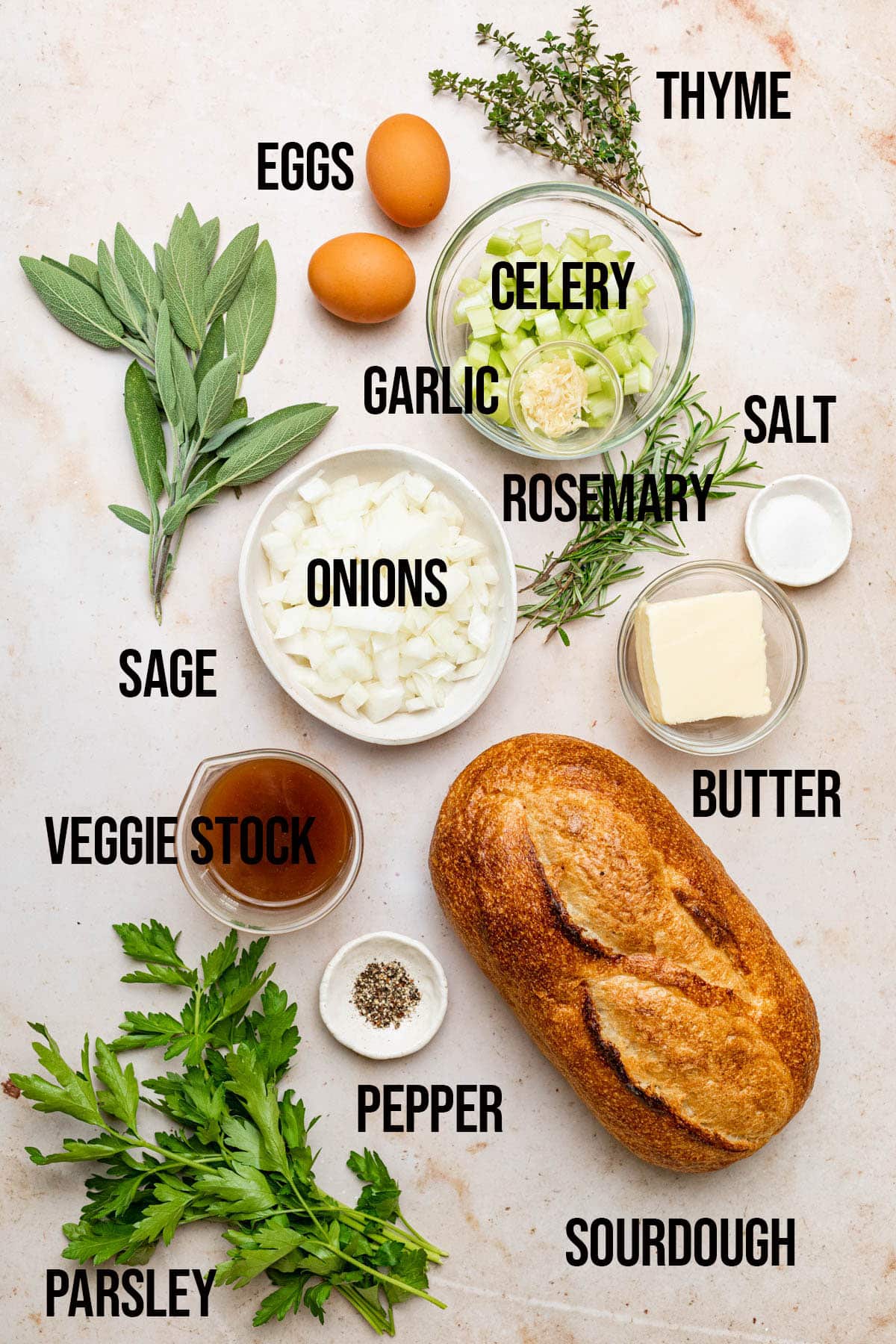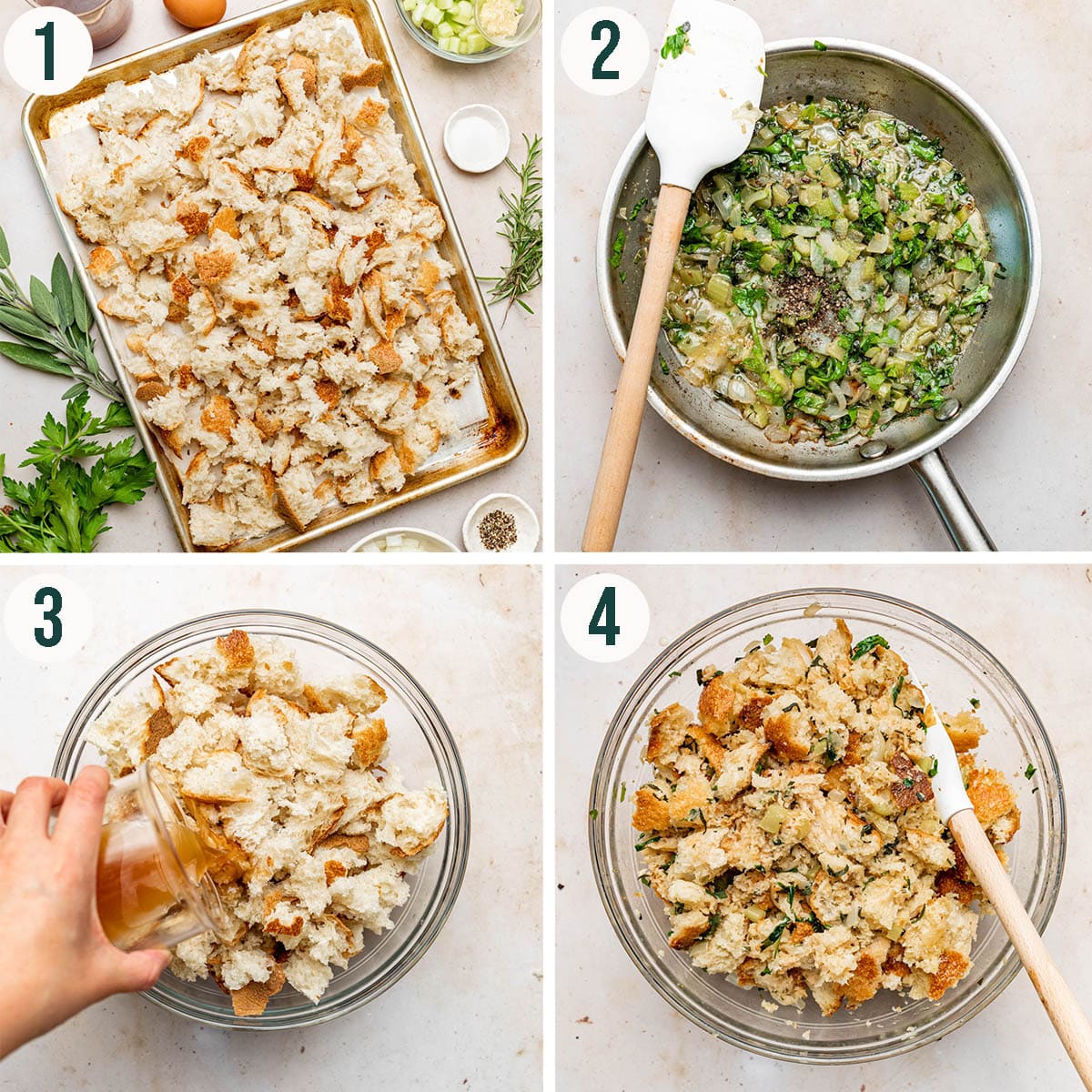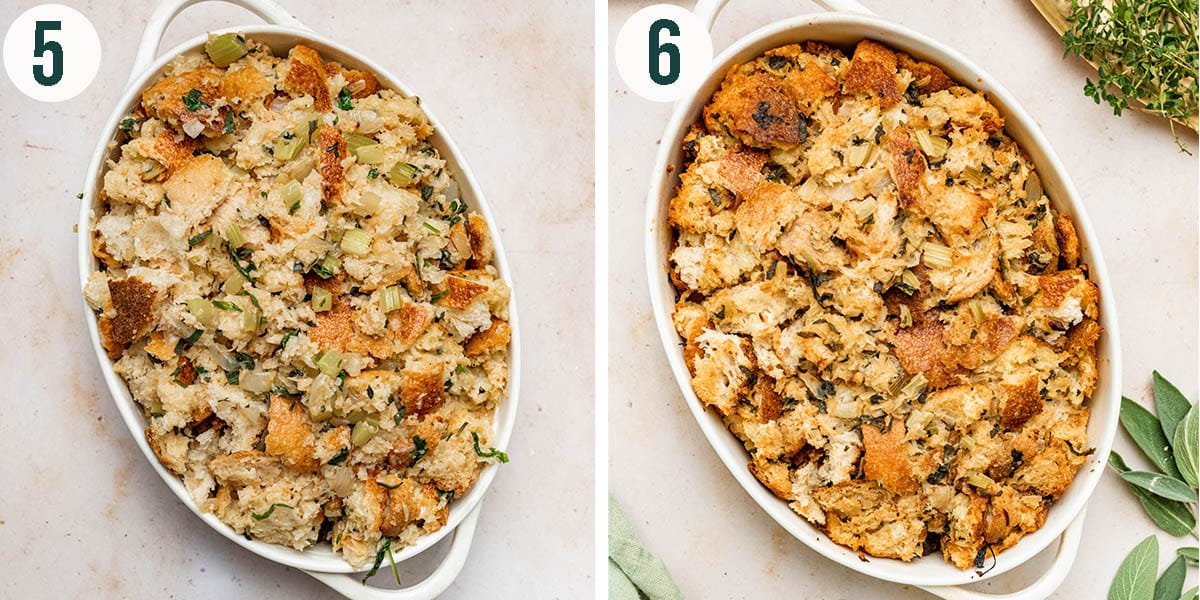This sourdough stuffing features classic herbal flavours, with sage, thyme, and rosemary. Sourdough bread adds an extra boost of complexity alongside plenty of butter, onion, and celery. Whether you call it stuffing or dressing, it's a delicious savoury bread pudding.
Use a flavoured sourdough loaf, like black pepper and rosemary or olive sourdough bread, to boost this recipe right from the base up.

Jump to:
Ingredients

Ingredient Notes and Substitutions
- Use a different sourdough: try using a flavoured loaf, like this apricot anise sourdough, in place of the plain bread.
- Add-ins: cooked sausage meat is a nice addition to the onion mixture if you have some you'd like to use up. Mix in a peeled and chopped apple to the onion mix if a hint of sweetness is your thing. Or, add a half cup of dried cranberries to the bowl when mixing the stuffing.
- Herbs: use dried herbs if you don't have fresh (about half the amounts called for). Poultry seasoning is a good alternative if you have it on hand, as is Herbes de Provence.
- Make it dairy-free: use a good vegan butter. Olive oil can be used in a pinch but it will have a different texture.
- Stock: Use a good vegetable broth, homemade if possible. This is a good neutral flavour so the stuffing goes well with any main dish. Chicken stock is a good substitute for vegetable broth, especially if you're planning on serving this with roast chicken. Beef broth is a bit too strong.
Method

Step 1: dry the bread pieces on a tray overnight or toast lightly in the oven.
Step 2: cook the onion, celery, and garlic, then mix in the herbs.
Step 3: pour the stock over the bread and mix.
Step 4: add the onion mixture to the bread and stir to combine, then mix in the eggs.

Step 5: transfer the mixture to a buttered baking dish.
Step 6: bake for about 50 minutes and serve warm.
Top Tips
- Make it ahead: to make ahead, get everything prepared and mixed. Place the stuffing into the baking dish, cover tightly, and refrigerate for up to 24 hours before baking as directed.
- Buy your bread: if you don't make your own sourdough, try asking a local bakery if they have any day-old loaves, as they'll be cheaper and work perfectly here.
- Use old bread: if using dry bread, you can skip the overnight or toasting step. 3-4 day old sourdough is perfect here.
Recipe Notes
After tearing the sourdough into pieces, we recommend drying it on a baking sheet overnight. A slightly stale loaf will absorb the liquid in the stuffing more effectively. If you don't have time for this step, toast the bread in a low-temperature oven (about 200°F) for about 20 minutes instead.
We haven't tried baking this specific stuffing in the chicken or turkey, and far prefer baking in in the serving dish for two reasons. First, it's easier to crisp - just remove the tin foil and bake another few minutes. Second, it looks much nicer to serve in the dish it's baked in.
How to Store
Storage: keep in the fridge, well covered or in a sealed container, for a day or two after baking. Reheat in the oven or on the stove, but it's best in the oven.
Freezing: transfer cooled stuffing to an airtight container and freeze for up to three months. Thaw in the fridge overnight and reheat in the oven.
FAQ
What is traditional stuffing made of?
Traditional stuffing is made with dry bread, butter, onion, and herbs. Some versions add sausage or other meats and it's common to add extra vegetables like celery.
What is stuffing called in England?
Like in Canada, stuffing is often called dressing in England. Although the term stuffing originated in England, the term was replaced in the 19th century.
What is dressing vs stuffing?
While some argue that the difference is that stuffing is cooked inside the turkey or chicken, and dressing is cooked separately, dressing vs. stuffing comes down to simple regional differences in language. It's the same thing.
If you make this Sourdough Dressing recipe or any other savoury recipes on the Baked Collective, please take a moment to rate the recipe and leave a comment below. It’s such a help to others who want to try the recipe. For more baking, follow along on Instagram, TikTok, and YouTube.
Classic Sourdough Stuffing
Equipment
- Measuring cups and spoons or a digital kitchen scale
- Baking tray
- Frying pan
- Spatula
- Mixing bowl
Ingredients
- 1 loaf sourdough bread torn into 1 inch cubes, or 12-14 cups (about 500g)
- ½ cup butter
- 2 cups onions chopped
- 1 ½ cups celery chopped
- 1 tablespoon minced garlic about 3 cloves
- ½ teaspoon salt more to taste if needed
- 1 teaspoon ground black pepper
- ⅓ cup parsley chopped
- 2 tablespoon thyme fresh
- 3 tablespoon sage chopped
- 1 teaspoon rosemary chopped
- 1 ½-2 cups vegetable stock
- 2 large eggs
Instructions
- Tear the sourdough into 1 inch (2.5 cm) cubes. Place the pieces on a baking tray and leave uncovered overnight to dry out—alternatively, you can toast the bread in a low oven (about 200°F for ~20 minutes) to help remove the moisture.
- Preheat the oven to 350°F (180°C). Grease a 9-inch (23 cm) square (or equivalent) baking dish with butter and set aside.
- Heat a frying pan over medium-low and add the butter.
- Once the butter is melted, add the onion, celery, and garlic. Cook, stirring often, until the veggies start to become tender and lightly golden, 8-10 minutes.
- Add the salt, pepper, parsley, thyme, sage, and rosemary, stirring until the herbs wilt and become fragrant. Remove from the heat and set aside to cool.
- Next, add the dried out bread to a large bowl. Pour 1 ½ cups of broth over the bread and mix to combine. Next add the cooled onion mixture and stir to combine. Add the eggs to the bowl.
- Using your hands or a spatula, gently mix well so that all of the bread is well coated. You may need to add ½ cup more broth if needed.
- Transfer the mixture to the baking dish. Cover with aluminum foil and bake for 35 minutes. Remove the foil and bake for 15-20 more minutes, or until desired crispness is reached.
- Serve immediately. Leftovers will keep for a couple days in the fridge and can be reheated in the microwave or on the stove top. Ideally, reheat in the oven to re-crisp the top.
Notes
- To make ahead, get everything prepared and mixed. Place the stuffing into the baking dish, cover tightly, and refrigerate for up to 24 hours before baking as directed.
- After tearing the sourdough into pieces, we recommend drying it on a baking sheet overnight. A slightly stale loaf will absorb the liquid in the stuffing more effectively. If you don’t have time for this step, toast the bread in a low-temperature oven (about 200°F) for about 20 minutes instead.





